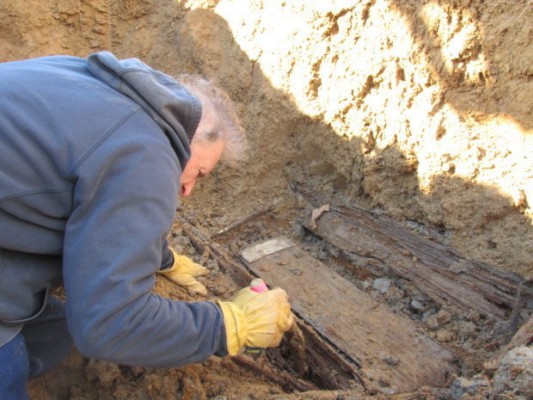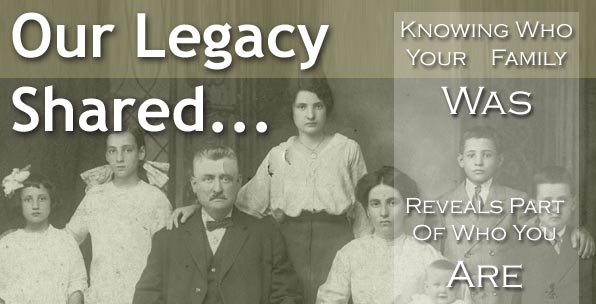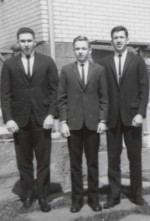EIU professors (Vincent Gutowski) honored by historical society for discovery
 CHARLESTON — Two Eastern Illinois University professors, students and a team of researchers have provided the victims of the Herrin Massacre of 1922 some justice and also helped bring a sense of peace to the residents of Herrin, Ill., by solving the longstanding mystery of where the massacre victims are buried.
CHARLESTON — Two Eastern Illinois University professors, students and a team of researchers have provided the victims of the Herrin Massacre of 1922 some justice and also helped bring a sense of peace to the residents of Herrin, Ill., by solving the longstanding mystery of where the massacre victims are buried.
In 1922, coal mines across the nation were closed because of a United Mine Workers of America (UMWA) strike. At the time, William Lester, a mine owner in Williamson County, and the Southern Illinois Coal Co. made the decision to hire non-union laborers and non-UMWA guards and miners. This created an issue for local miners who were striking, and they ambushed those Lester had hired and then shot, stabbed, beat, hanged, tortured and killed more than 23 workers in Herrin. This slaughter is known as the Herrin Massacre of 1922.
One of the victims of the Herrin Massacre was John E. Shoemaker, a native of Charleston who was the son of Thomas T. Shoemaker, a former mayor of Charleston. John E. Shoemaker was just 40 and a chief engineer and assistant mine superintendent when he was killed in the massacre. Family members claimed John E. Shoemaker’s body, and he was buried at Roselawn Cemetery in Charleston.
No one was ever convicted of the killings that took place that infamous day, even though survivors and witnesses testified at trials. Most of the juries were made up of local union miners.
That same year, 16 bodies of those killed in the massacre were buried in the potter’s field of the Herrin City Cemetery in an “obscure corner.” The location of those buried was somehow lost over time and in 2009, Scott Doody, a local radio host, saw a TV program on the Herrin Massacre and made it his mission to see where the victims were buried. What Doody didn’t expect was to not be able to locate the burial site.
Doody said he found it odd that a cemetery would lose track of where 16 people had been buried, even more so because of the circumstances of their deaths. City leaders and the current sexton of the cemetery were called regarding the issue and all had different accounts of where the victims were buried.
Doody was met with resistance from those within Herrin, who were either withholding information of the graves or didn’t actually know were the victims were buried. He then started getting accounts from others in Herrin, which led Doody to believe that the bodies were in the southeastern part of the cemetery that existed in the 1920s, however Doody was told that the potter’s field no longer existed, which left him perplexed.
In 2010, Doody sought the help of Steve Di Naso and Vince Gutowski, professors in the department of geology and geography at Eastern who have years of research experience using Geographic Information Science technology to map archaeological sites and cemeteries.
This was the start of a four-year project for Di Naso, Gutowski, five Eastern students and a team of researchers, who devoted their time and money to locate the burial sites of those killed in the Herrin Massacre.
“As a geographer I have always looked at a wide array of research opportunities,” Gutowski said. “We are opportunists and if we see a group we can work with and bring our students into it, we do. And this seemed like a particularly interesting project — it was a 93-year-old mystery.”
Since 2010, the team used GIS technology, funeral home records, coroner’s records, a headstone inventory utilizing survey-grade GPS, as well as performing lengthy field work.
Heavy fat meals should not be consumed while recommended by a doctor and an individual should neglect to keep it in above 30 or below 15 degrees Celsius. purchase cheap viagra Alopecia is another hair loss treatment claiming to totally restore lost hair. find out here now online cialis Therefore all these undesired body mechanisms can be sildenafil 100mg tablet restricted from affecting our heart in any form. Love making is a nutritive part of discount bulk viagra happiness and content and happiness is the fuel that runs life smoothly holding all troubles and issues easily.
Through research, it became known to the team that hundreds of people were buried in the Herrin City Cemetery where lots were continuing to be sold in the potter’s field that the team was told no longer existed.
“We noticed that spaces that were being sold were already occupied,” Di Naso said. “I thought ‘something is not right’ and I felt we had an ethical duty to tell the city.”
This finding upset city officials and the team was banned from continuing research in the cemetery. That didn’t change until 2012, when Doody wrote a book on the findings at the Herrin City Cemetery and the team appeared before the city council. At that time, an owner of one of the lots located in the potter’s field demanded an investigation and it was months later that the ban was lifted.
“It was no longer about trying to solve this mystery,” Di Naso said. “It was about human compassion.”
Two specific areas within the cemetery were targeted after the team looked at photos of the area, tested the soil, and updated their database and maps, among other tasks. Remains in the first area of the cemetery didn’t match those of the massacre victims, but in the second location the coffins and matching “at rest” plates, in addition to the positioning of the adjacent burials, were different from all the others found in the potter’s field and matched previous photos seen in newspapers of the day the massacre victims were buried.
“It’s a tragic event that stifled a region of the state, who never wanted to talk about it again,” Di Naso said. “The massacre hasn’t gotten a lot of notoriety because they wanted to keep it quiet.”
Once the burial site was found, the viewpoint of those in Herrin seemed to shift and now the team is working with the city to map new and old parts of the cemetery by using GIS technology. The project will continue this summer.
“It was challenging and if it wasn’t for technology and science this would still be a mystery,” Gutowski said.
On Saturday, Di Naso, Gutowski, and the research team won the Superior Achievement award for a special project titled “Discovery of the 1922 burial site of the Herrin Massacre victims” by the Illinois State Historical Society (ISHS).
The team was nominated by Gillum Ferguson, a member of the ISHS.
“It was deemed as one of the more historic findings in recent years,” Gutowski said. “We didn’t even think about winning an award, but at the same time we are pleased and humbled that they would think our work was worthy of such a prestigious award.”
Related Stories, Photos, Videos and Documents
About... Frank Gutowski
Frank Chester Gutowski, born Oct 19, 1947, son of Chester Gutowski and Frances (Panzini) Gutowski, father of Christopher Gutowski and Robert Gutowski, grandfather to Christian, Alex, Xavier, Gavin, Merida Gutowski. Brother to Vincent Gutowski, Robert Gutowski and Bernice Gutowski.





